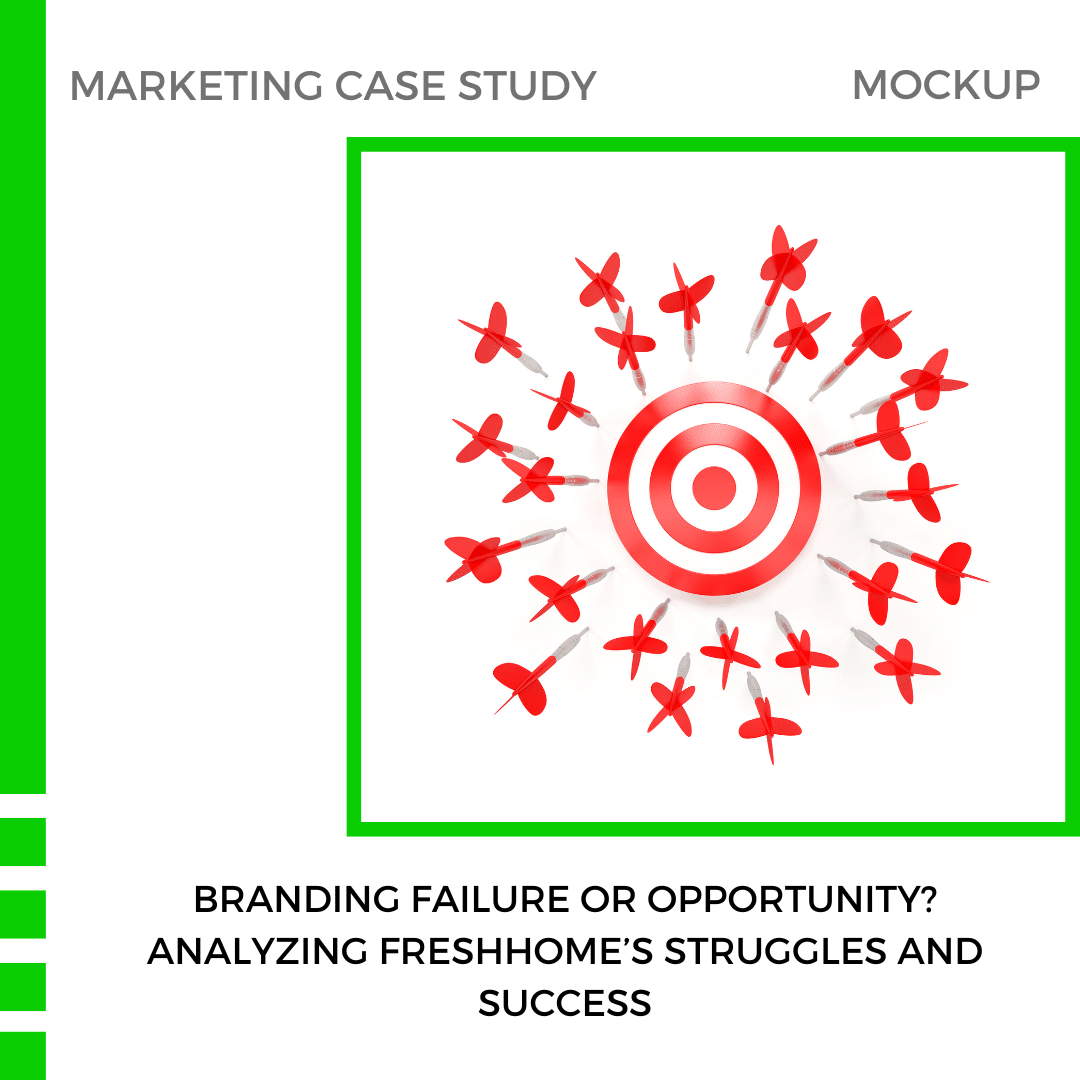
Branding Failure or Opportunity? Analyzing FreshHome’s Struggles and Success
Building a strong brand is crucial for companies aiming to shape consumer perceptions and gain market prominence. However, even the most well-constructed brands can face branding failure, often due to the complexities of differing markets. This case study analyzes the hypothetical eco-friendly brand FreshHome, which struggled with branding failure in its U.S. home market but achieved notable success in Germany. Students will examine the causes behind this branding failure domestically and analyze FreshHome’s international triumph, formulating strategies to overcome similar challenges.
FreshHome’s situation highlights the need to understand how a single branding approach may not work in all markets, emphasizing the importance of cultural adaptation, pricing flexibility, and effective distribution. This case offers a foundation for understanding why some brands thrive internationally while failing to gain traction locally, making it an invaluable study in branding resilience.
Objectives
- Recognize the core elements contributing to branding success and failure.
- Analyze the specific causes behind FreshHome’s branding failure in the U.S. market.
- Evaluate factors contributing to FreshHome’s success in Germany.
- Propose strategic adjustments to improve FreshHome’s branding performance in the U.S.
Background Information
Key Branding Concepts
Branding: Establishing a distinct image for a product that resonates with consumers.
Market Segmentation: Categorizing consumers based on needs and preferences.
Cultural Adaptation: Adjusting branding to align with cultural expectations.
Consumer Perception: How consumers view a brand based on various factors, including brand interactions and societal values.
For additional resources on branding strategies, students can explore Branding Resources on Investopedia.
The Company: FreshHome
FreshHome specializes in eco-friendly home cleaning products, prioritizing sustainable ingredients and recyclable packaging. While its environmentally friendly focus aligns with consumer values, FreshHome encountered challenges in its home market that limited brand loyalty. These branding failures contrast sharply with the brand’s success in the German market, where FreshHome thrived. Understanding these differences will illuminate how branding strategies must adapt to diverse market conditions.
Branding Failure in the U.S. Market
U.S. Market Overview
Country: United States
Target Audience: Environmentally conscious consumers aged 25-45
Product Line: All-purpose cleaners, laundry detergents, dish soaps, and air fresheners
Reasons for Branding Failure
- Market Saturation: The U.S. eco-friendly cleaning product market is highly competitive, with many brands offering similar products. FreshHome struggled to stand out amidst established competitors, resulting in limited market penetration.
- Pricing Strategy: FreshHome’s premium pricing alienated price-sensitive consumers who perceived the products as costly relative to established brands. This misalignment between price and perceived value became a significant branding failure.
- Distribution Limitations: FreshHome’s limited availability in major retail chains restricted its visibility. By depending heavily on niche health stores and online platforms, FreshHome’s products were harder for the average consumer to find, limiting accessibility.
- Ineffective Marketing Campaigns: FreshHome’s branding focused primarily on environmental benefits but lacked emotional engagement. Without a compelling narrative or engaging ads, FreshHome’s efforts fell flat, impacting brand loyalty.
Consumer Feedback on Branding Failure
- Perceived Overpricing: FreshHome’s premium costs deterred many buyers, who felt the price was unjustified.
- Accessibility Issues: Limited distribution caused consumer frustration, with some abandoning the brand.
- Lack of Connection: FreshHome failed to build a personal connection, which impacted brand loyalty and contributed to its branding failure.
Success in the German Market
German Market Overview
Country: Germany
Target Audience: Eco-conscious consumers aged 25-45
Product Line: All-purpose cleaners, laundry detergents, dish soaps, and air fresheners
Reasons for International Success
- Cultural Alignment: FreshHome’s eco-friendly focus resonated well with German consumers prioritising sustainability. This cultural fit made FreshHome’s brand image align naturally with the values of its target market.
- Competitive Pricing Strategy: FreshHome’s pricing in Germany was adjusted to appear affordable without sacrificing quality. This balance helped the brand appeal to price-sensitive yet quality-conscious German consumers.
- Strong Distribution Network: Partnerships with major retail chains and online platforms increased visibility, making FreshHome’s products readily accessible.
- Localized Marketing: FreshHome used marketing campaigns emphasising health and environmental benefits, further validated through collaborations with eco-friendly influencers. This local touch made the brand more relatable and trustworthy.
Consumer Feedback on Success
- Affordable Quality: FreshHome’s blend of quality and affordability was well-received.
- Convenient Availability: Distribution through popular supermarkets made it easy for consumers to find FreshHome products.
- Positive Brand Association: FreshHome’s alignment with German values boosted its image and consumer loyalty.
Case Study Analysis
Task 1: Assessing Branding Failure in the U.S.
- Competitive Landscape Analysis: Evaluate how U.S. market saturation impacted FreshHome’s ability to establish itself.
- Pricing Evaluation: Explore how FreshHome’s premium pricing strategy affected sales and suggest pricing adjustments to enhance appeal.
- Distribution Strategy Critique: Assess FreshHome’s distribution strategy and propose ways to improve product accessibility.
- Marketing Effectiveness: Review FreshHome’s branding approach and suggest alternative campaigns to foster a stronger emotional connection with consumers.
Task 2: Evaluating International Success in Germany
- Cultural Fit: Discuss how aligning with German environmental values contributed to FreshHome’s success.
- Effective Pricing Strategy: Examine the role of FreshHome’s pricing adjustments in appealing to German consumers.
- Distribution Effectiveness: Identify successful distribution methods in Germany and discuss possible applications in other markets.
- Localized Marketing: Analyze the role of influencer partnerships and localized messaging in FreshHome’s positive brand perception.
Task 3: Propose Recommendations for Home Market Improvement
1. Differentiation Strategies:
- Propose strategies to differentiate FreshHome from competitors in the U.S. market.
- Discuss the importance of unique selling propositions (USPs) in standing out.
2. Revised Pricing Strategy:
- Suggest pricing strategies that balance affordability with perceived value.
- Discuss potential promotions and discounts to attract price-sensitive consumers.
3. Enhanced Distribution:
- Propose distribution strategies to increase product availability in major retail chains.
- Discuss the role of e-commerce in expanding market reach.
4. Improved Marketing:
- Recommend marketing approaches that build an emotional connection with consumers.
- Discuss the use of storytelling, influencer partnerships, and social media engagement.
Financial and Market Data for Analysis
Home Market (U.S.)
| Metric | Before Campaign | During Campaign | After Campaign |
|---|---|---|---|
| Sales Revenue | $1,000,000 | $1,200,000 | $1,100,000 |
| Market Share | 2% | 2.5% | 2.2% |
| Brand Awareness | 30% | 35% | 32% |
| Customer Satisfaction | 60% | 55% | 57% |
International Market (Germany)
| Metric | Before Campaign | During Campaign | After Campaign |
|---|---|---|---|
| Sales Revenue | $500,000 | $1,500,000 | $1,800,000 |
| Market Share | 1% | 3% | 3.5% |
| Brand Awareness | 20% | 50% | 55% |
| Customer Satisfaction | 70% | 85% | 90% |
Solution for Improving U.S. Market Strategy
To reverse FreshHome’s branding failure in the U.S., FreshHome could adopt a dual strategy focused on differentiation and emotional connection:
- Refined Differentiation Strategy: To stand out in the crowded U.S. market, FreshHome should emphasize its unique features, such as biodegradable packaging and allergen-free formulas. Creating a strong, unique selling proposition (USP) highlighting these features will make FreshHome more memorable.
- Flexible Pricing with Entry Offers: Offering an entry-level line or periodic discounts could make FreshHome products more accessible to price-sensitive consumers without compromising its premium image.
- Expanded Distribution Channels: By establishing partnerships with large retail chains like Target or Walmart, FreshHome can increase visibility and reach more consumers. An enhanced e-commerce strategy, especially on platforms like Amazon, would further broaden its market.
- Emotional Marketing: FreshHome should adopt a storytelling approach in its advertising, focusing on relatable narratives around health, family safety, and eco-friendly lifestyles. Partnering with influencers who advocate for sustainability could also improve brand trust and emotional resonance.
For more insights on branding and distribution strategies, visit Harvard Business Review.
Conclusion
This case study on FreshHome underscores the importance of adaptable branding strategies. By examining FreshHome’s branding failure in the U.S. and success in Germany, students can see how tailoring brand identity to align with specific market expectations is crucial for success. As markets evolve, brands must be agile, adjusting their strategies based on cultural insights, pricing, and consumer needs. With thoughtful adjustments, FreshHome has the potential to overcome its branding failure in the U.S. and achieve consistent success across markets.
Explore Business Models of Global Companies and Indian Companies
Tag:branding challenges, branding failure, branding strategies, case studies, case study, competitive branding, cultural adaptation, distribution strategy, eco-friendly branding, FreshHome case study, international success, market differentiation, marketing case study, mockup case study, premium pricing, U.S. branding issues



